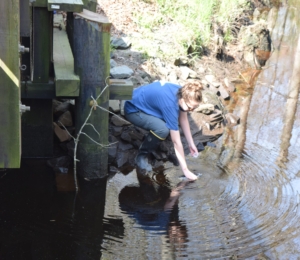
SERC Biological Technician Gabriella Marafino collecting a water sample for eDNA analysis. Credit: SERC.
Two types of river herring, alewife and blueback herring, used to be abundant in tributaries of the Chesapeake Bay . These days, however, herring are threatened by habitat loss, overfishing, and dams that block the route to their spawning locations.
Teams from the Smithsonian Environmental Research Center (SERC) and the Horn Point Laboratory at the University of Maryland Center for Environmental Science (UMCES) are working together to better define where the river herring are now, and whether the two species of herring might prefer different parts of the Bay for spawning habitat. They are looking at environmental DNA, or eDNA, collected from water samples from hundreds of locations. River herring eDNA is from eggs, waste, and slime left behind as they swim, leaving clues as to their presence or absence in certain locations.
The main application of this work is to “understand the broad-scale habitat use and how that relates to land use, habitat quality, and applications to management,” explains Matt Ogburn, the lead on the team from SERC. Herring are anadromous, living in the ocean but spawning in freshwater habitats upstream. Dams often block herring from reaching spawning habitats, contributing to population decline. Ogburn serves on the Chesapeake Bay Program Fish Passage Workgroup, and is looking into locations where dams have been removed in the past to see if herring have moved upstream. In order to advocate for future dam removals to help migratory fish, Ogburn explains, scientists need to know if there are fish downstream. This is where their research could potentially offer important answers to questions of abundance.
In the past, scientists have tried to measure abundance by using fine mesh nets to capture fish eggs. But the fish eggs of herring and another river species, shad, are difficult to tell apart. Another issue is that they can only collect the eggs when the fish are spawning, potentially giving inaccurate abundance numbers. They’ve also used sonar to find fish underwater, but this method is expensive and allows for only a few sampling locations (two in their last sampling effort). With eDNA, Ogburn’s team can take bottles of water from hundreds of sites and send them to a genetics lab for testing. Genetic testing is led by Louis Plough of UMCES.
Plough’s team uses a two-step process to identify the herring DNA. The first step is to separate river herring DNA from other fish species, like shad. For this, Plough designed a “molecular beacon” probe that matches specifically to the part of the DNA associated with herring so that only herring DNA is amplified in a polymerase chain reaction (PCR) assay. This tells the scientists how much herring DNA is at the testing location, giving them some idea of abundance. In the second step, Plough’s team goes back to the original DNA samples and looks at larger pieces of DNA. The longer pieces have genetic information that can be used to parse out the different herring species, helping them identify where alewife and blueback herring might be located. The purpose of the two step process is to measure the abundance of herring in general and then parse out the specific locations of the two species of herring.

Marafino again collecting a water sample. Credit: SERC.
They found that alewife herring tend to be present on the Bay’s eastern shore, while blueback herring tend to be more common on the western shore. Rivers on the eastern shore are slower-moving coastal plain streams, whereas many streams on the western shore are clearer, faster flowing, coming from the Piedmont. Differences in herring abundance could be due to different environmental factors on the eastern and western shores, but it could also be genetic differences in the fish. This is the first time this pattern has been detected, so further research will be needed to better understand geographic differences.
The team is also interested in finding funding to train citizen scientists to collect water samples, possibly expanding the number of testing locations, and to fund increased sample processing. Other research teams are looking into matching eDNA to adult fish numbers more directly in order to get better abundance numbers. Together, this research will help strengthen Bay management decisions and could help fish populations across the watershed.
